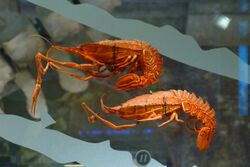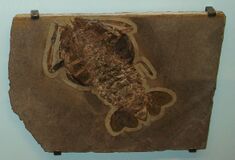Biology:Polychelida
| Polychelida | |
|---|---|

| |
| Stereomastis sculpta | |
| Scientific classification | |
| Script error: No such module "Taxobox ranks".: | Animalia |
| Script error: No such module "Taxobox ranks".: | Arthropoda |
| Script error: No such module "Taxobox ranks".: | Malacostraca |
| Script error: No such module "Taxobox ranks".: | Decapoda |
| Script error: No such module "Taxobox ranks".: | Pleocyemata |
| Script error: No such module "Taxobox ranks".: | Reptantia |
| Script error: No such module "Taxobox ranks".: | Polychelida Scholtz & Richter, 1995 [1] |
| Families | |
| |
Polychelida is an infraorder of decapod crustaceans. Fossil representatives are known dating from as far back as the Upper Triassic. A total of 38 extant species, all in the family Polychelidae, and 55 fossil species have been described.
History
Polychelida had traditionally been included in the infraorder Palinura, alongside the spiny lobsters and slipper lobsters (now in the infraorder Achelata).[1][2] In 1995, Gerhard Scholtz and Stefan Richter of the Freie Universität Berlin carried out a phylogenetic study of the "Reptantia", and concluded that "Palinura" was paraphyletic. They therefore abandoned that taxon and introduced instead the new clade Polychelida.[1]
Classification
Polychelida belongs to the group Reptantia, which consists of the walking/crawling decapods (lobsters and crabs). Polychelida is the sister clade to the infraorder Astacidea, which contains the "true" lobsters and crayfish. The cladogram below shows Polychelida's placement within the larger order Decapoda, from analysis by Wolfe et al., 2019.[3]
| Decapoda |
| |||||||||||||||||||||||||||||||||||||||||||||||||||||||||||||||
The animals grouped into the infraorder Polychelida are united by the presence of at least four pairs of chelae (claws).[4] Five families are included, all but one of which are extinct.[5] The 38 extant species are all in the family Polychelidae.[5] The group has a fossil record stretching back to the Upper Triassic,[2] and had its peak diversity in the Mesozoic.[4] Although the extant species are all restricted to deep waters, the group is thought to have originated in shallow water.[4] Over time, the eyes have reduced in size to the vestigial state seen in extant Polychelidae, the body has narrowed, and the chelae have become less robust; among extant taxa, the most plesiomorphic state is seen in Willemoesia.[4]
References
- ↑ 1.0 1.1 1.2 Gerhard Scholtz; Stefan Richter (1995). "Phylogenetic systematics of the reptantian Decapoda (Crustacea, Malacostraca)" (PDF). Zoological Journal of the Linnean Society 113 (3): 289–328. doi:10.1111/j.1096-3642.1995.tb00936.x. http://decapoda.nhm.org/pdfs/826/826.pdf.
- ↑ 2.0 2.1 Hiroaki Karasawa; Fumio Takahashi; Eiji Doi; Hideo Ishida (2003). "First notice of the family Coleiidae Van Straelen (Crustacea: Decapoda: Eryonoidea) from the upper Triassic of Japan" (PDF). Paleontological Research 7 (4): 357–362. doi:10.2517/prpsj.7.357. http://decapoda.nhm.org/pdfs/17961/17961.pdf.
- ↑ Wolfe, Joanna M.; Breinholt, Jesse W.; Crandall, Keith A.; Lemmon, Alan R.; Lemmon, Emily Moriarty; Timm, Laura E.; Siddall, Mark E.; Bracken-Grissom, Heather D. (24 April 2019). "A phylogenomic framework, evolutionary timeline and genomic resources for comparative studies of decapod crustaceans". Proceedings of the Royal Society B 286 (1901). doi:10.1098/rspb.2019.0079. PMID 31014217. PMC 6501934. https://royalsocietypublishing.org/doi/10.1098/rspb.2019.0079.
- ↑ 4.0 4.1 4.2 4.3 Shane T. Ahyong (2009). "The polychelidan lobsters: phylogeny and systematics (Polychelida: Polychelidae)" (PDF). Decapod Crustacean Phylogenetics. Crustacean Issues. 18. CRC Press. pp. 369–396. ISBN 978-1-4200-9258-5. http://decapoda.nhm.org/pdfs/30831/30831.pdf.
- ↑ 5.0 5.1 Sammy De Grave et al. (2009). "A classification of living and fossil genera of decapod crustaceans". Raffles Bulletin of Zoology Suppl. 21: 1–109. http://rmbr.nus.edu.sg/rbz/biblio/s21/s21rbz1-109.pdf.
External links
Wikidata ☰ Q1468386 entry
 |




